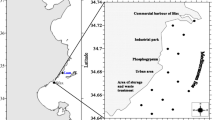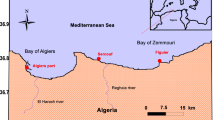Abstract
The concentrations of 11 heavy metals (Ag, Cd, Co, Cr, Cu, Fe, Mn, Ni, Pb, V and Zn) were measured in the tissues (digestive gland, branchial hearts, gills, digestive tract, kidney, genital tract, muscle, skin, shell) of the two cephalopods Eledone cirrhosa (d'Orb.) and Sepia officinalis (L.) collected from the French coast of the English Channel in October 1987. The tissues of both species displayed a similar pattern of heavy-metal accumulation: the digestive gland, branchial hearts and kidney were the major sites of concentration for all 11 metals; the digestive gland accumulated silver, cadmium, cobalt, copper, iron, lead and zinc, the branchial hearts high concentrations of copper, nickel and vanadium, and the kidney high concentrations of manganese, nickel and lead. The digestive gland, which constituted 6 to 10% of the whole-animal tissue, contained >80% of the total body burden of Ag, Cd and Co and from 40 to 80% of the total body burden of the other metals. The ratios between heavy metal concentrations in the digestive gland and those in the muscle separated the elements into three groups, those with a ratio ≤10 (Cr, Mn, Ni, Pb, V, Zn), those with a ratio >10 to <50 (Co, Cu, Fe), and those with a ratio ≥50 (Ag, Cd). The digestive gland of cephalopods (carnivorous molluscs whose age can be easily calculated with great accuracy) would seem to constitute a good potential indicator of heavy metal concentrations in the marine environment.
Similar content being viewed by others
Literature cited
Belcari, P., Fedi, E., Sartor, P. (1990). Analysis of the sexual development of Eledone cirrhosa (Cephalopoda Octopoda) in the northern Tyrrhenian Sea through two maturity indices. Rapp. P.-v. Réun. Commu int. Explor. scient. Mer Méditerr. 32: p. 241
Bidder, A. M. (1957). Evidence for an absorptive function in the “liver” of Octopus vulgaris Lam. Pubbl. Staz. zool. Napoli 29: 139–150
Boletzky, S., von (1989). Réflexion sur les facteurs du déterminisme des migrations chez les céphalopodes. Océanis, Paris 15: 115–120
Boucaud-Camou, E. (1968). Etude histologique et histochimique de l'appareil digestif de Sepiola atlantica d'Orbigny et Sepia officinalis L. Bull. Soc. linn. Normandie 9: 220–243
Boucaud-Camou, E., Boismery, J. (1991). The migrations of the cuttlefish (Sepia officinalis L.) in the English Channel. In: Boucaud-Camou E. (ed.) La seiche. Université de Caen, p. 179–189
Boucaud-Camou, E., Boucher-Rodoni, R., Mangold, K. (1976). Digestive absorption in Octopus vulgaris (Cephalopoda: Octopoda). J. Zool., Lond. 179: 261–271
Boucaud-Camou, E., Péquignat, E. (1973). Etude expérimentale de l'absorption digestive chez Sepia officinalis L. (mollusque céphalopode). Forma Functio 6: 93–113
Bryan, G. W. (1973). The occurrence and seasonal variation of trace metals in the scallops Pecten maximus (L.) and Chlamys opercularis (L.). J. mar. biol. Ass. U.K. 53: 145–166
Bryan, G. W. (1984). Pollution due to heavy metals and their compounds. In: Kinne O. (ed.) Marine ecology. Vol. 5. Part 3. Chichester, Wiley-Interscience, p. 1289–1431
Bryan, G. W., Hummerstone, L. G. (1978). Heavy metals in the burrowing bivalve Scrobicularia plana from contaminated and uncontaminated estuaries. J. mar. biol. Ass. U.K. 58: 401–419
Bryan, G. W., Potts, G. W., Forster, G. R. (1977). Heavy metals in the gastropod mollusc Haliotis tuberculata (L.). J. mar. biol. Ass. U.K. 57: 379–390
Coombs, T. L., George, S. G. (1978). Mechanisms of immobilization and detoxification of metals in marine organisms. In: McLusky D. S., Berry A. J. (eds.) Physiology and behaviour of marine organisms. Oxford and New York, Pergamon Press, p. 179–187
Cuénot, K., Gonet, V., Bruntz, L. (1908). Recherches chimiques sur les cœurs branchiaux des céphalopodes. Démonstration du rôle excréteur des cellules qui éliminent le carmin ammoniacal des injections physiologiques. Archs Zool. exp. gén. (Notes Rev.) 9(3): 49–53
Decleir, W., Vlaeminck, A., Geladi, P., Van Grieken, R. (1978). Determination of protein-bound copper and zinc in some organs of the cuttlefish Sepia officinalis L. Comp. Biochem. Physiol. 60 B: 347–350
Finger, J. M., Smith, J. D. (1987). Molecular association of Cu, Zn, Cd, and 210Po in the digestive gland of the squid Nototodarus gouldi. Mar. Biol 95: 87–91
Fox, D. L., Updegraff, D. M. (1943). Adenochrome, a glandular pigment in the branchial hearts of the octopus. Archs Biochem. 1: 339–356
Ghiretti-Magaldi, A., Guiditta, A., Ghiretti, F. (1958). Pathways of terminal respiration in marine invertebrates. I. The respiratory system in cephalopods. J. cell. comp. Physiol. 52: 389–429
Guary, J. C., Fowler, S. W. (1982). Experimental studies on the biokinetics of plutonium and americium in the cephalopod Octopus vulgaris. Mar. Ecol. Prog. Ser. 7: 327–335
Guary, J. C., Higgo, J. J. W., Cherry, R. D., Heyraud, M. (1981). High concentrations of transuranics and natural radioactive elements in the branchial hearts of the cephalopod Octopus vulgaris. Mar. Ecol. Prog. Ser. 4: 123–126
Horowitz, A., Presley, B. J. (1977). Trace metal concentrations and partitioning in zooplankton, neuston, and benthos from the south Texas outer continental shelf. Archs envir. Contam. Toxic. 5: 241–255
Leatherland, T. M., Burton, J. D. (1974). The occurrence of some trace metals in coastal organisms with particular reference to the Solent region. J. mar. biol. Ass. U.K. 54: 457–468
Martin, A. W., Harrison, F. M. (1966). Excretion. In: Wilbur, K. M., Yonge C. M. (eds.) Physiology of Mollusca. Vol. II. New York, Academic Press, p. 353–386
Martin, J. H., Flegal, A. R. (1975). High copper concentrations in squid livers in association with elevated levels of silver, cadmium, and zinc. Mar. Biol. 30: 51–55
Medhioub, A. (1986). Etude de la croissance et du cycle sexuel de la seiche (Sepia officinalis L.) des côtes normandes. Thèse de 3ème cycle. Université de Caen
Medhioub, A., Boucaud-Camou, E. (1992). Etude de la maturation gonadique de la seiche Sepia officinalis L. des côtes normandes. Haliotis, Paris 19: (in press)
Miramand, P., Guary, J. C. (1980). High concentrations of some heavy metals in tissues of the Mediterranean octopus. Bull. envir. Contam. Toxic. 24: 783–788
Miramand, P., Guary, J. C. (1981). Association of americium-241 with adenochromes in the branchial hearts of the cephalopod Octopus vulgaris. Mar. Ecol. Prog. Ser. 4: 127–129
Miramand, P., Lafaurie, M., Fowler, S. W., Lemaire, P., Guary, J. C., Bentley, D. (1991). Reproductive cycle and heavy metals in the organs of red mullet, Mullus barbatus (L.) from the north-western Mediterranean. Sci. total Envir. 103: 47–56
Nakahara, M., Koyanagi, T., Ueda, T., Shimizu, C. (1979). Peculiar accumulation of cobalt-60 by the branchial hearts of octopus. Bull. Jap. Soc. scient. Fish. 45: p. 539
Nardi, G., Muzii, E. O., Puca, M. (1971). Ferritin in the hepatopancreas of Octopus vulgaris Lam. Comp. Biochem. Physiol. 40 B: 199–205
Nardi, G., Steinberg, H. (1974). Isolation and distribution of adenochrome(s) in Octopus vulgaris. Comp. Biochem. Physiol. 48B: 453–461
Renzoni, A., Bacci, E., Falciai, L. (1973). Mercury concentration in the water, sediments and fauna of an area of the Thyrrhenian coast. Revue int. Océanogr. méd. 31–32: 17–45
Richard, A. (1971). Contribution à l'étude expérimentale de la croissance et de la maturation sexuelle de Sepia officinalis L. (mollusque céphalopode). Thèse Doctorat d'Etat, Sciences. Université de Lille
Rocca, E. (1969). Copper distribution in Octopus vulgaris Lam. hepatopancreas. Comp. Biochem. Physiol. 28: 67–82
Schipp, R., Hevert, F. (1978). Distribution of copper and iron in some central organs of Sepia officinalis (Cephalopoda). A comparative study by flameless atomic absorption and electron microscopy. Mar. Biol. 47: 391–399
Schipp, R., von Boletzky, S. (1975). Morphology and function of the excretory organs in dibranchiate cephalopods. Fortschr. Zool. 23: 89–11
Segar, D. A., Collins, J. D., Riley, J. P. (1971). The distribution of the major and some minor elements in marine animals. Part II. Molluscs. J. mar. biol. Ass. U.K. 51: 131–136
Shackley, S. E., King, P. E., Gordon, S. M. (1981). Vitellogenesis and trace metals in a marine teleost. J. Fish Biol. 18: 349–352
Smith, J. D., Plues, L., Heyraud, M., Cherry, R. D. (1984). Concentrations of the elements Ag, Al, Ca, Cd, Cu, Fe, Mg, Mn, Pb and Zn and the radionuclides 210Pb and 210Po in the digestive gland of the squid Nototodarus gouldi. Mar. envir. Res. 13: 55–68
Suzuki, Y., Nakahara, M., Nakamura, R. (1978). Accumulation of cesium-137 by useful Mollusca. Bull. Jap. Soc. scient. Fish. 44: 325–329
Tanaka, T., Hagashi, Y., Ishizawa, M. (1983). Subcellular distribution and binding of heavy metals in the untreated liver of the squid; comparison with data from the livers of cadmium and silver-exposed rats. Experientia 39: 746–748
Ueda, T., Nakahara, M., Ishii, T., Suzuki, Y., Suzuki, H. (1979). Amounts of trace elements in marine cephalopods. J. Radiat. Res. 20: 338–342
Author information
Authors and Affiliations
Additional information
Communicated by J. M. Pérès, Marseille
Rights and permissions
About this article
Cite this article
Miramand, P., Bentley, D. Concentration and distribution of heavy metals in tissues of two cephalopods, Eledone cirrhosa and Sepia officinalis, from the French coast of the English Channel. Marine Biology 114, 407–414 (1992). https://doi.org/10.1007/BF00350031
Accepted:
Issue Date:
DOI: https://doi.org/10.1007/BF00350031




